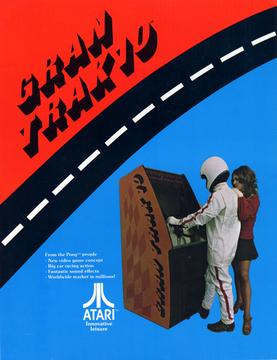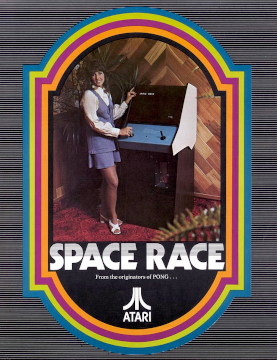
Atari is a brand name that has been owned by several entities since its inception in 1972. It is currently owned by French company Atari SA through a subsidiary named Atari Interactive. The original Atari, Inc., founded in Sunnyvale, California, in 1972 by Nolan Bushnell and Ted Dabney, was a pioneer in arcade games, home video game consoles and home computers. The company's products, such as Pong and the Atari 2600, helped define the electronic entertainment industry from the 1970s to the mid-1980s.

The Atari 2600 is a home video game console developed and produced by Atari, Inc. Released in September 1977, it popularized microprocessor-based hardware and games stored on swappable ROM cartridges, a format first used with the Fairchild Channel F in 1976. Branded as the Atari Video Computer System from its release until November 1982, the VCS was bundled with two joystick controllers, a conjoined pair of paddle controllers, and a game cartridge—initially Combat and later Pac-Man.

Pong is a table tennis–themed twitch arcade sports video game, featuring simple two-dimensional graphics, manufactured by Atari and originally released in 1972. It was one of the earliest arcade video games; it was created by Allan Alcorn as a training exercise assigned to him by Atari co-founder Nolan Bushnell, but Bushnell and Atari co-founder Ted Dabney were surprised by the quality of Alcorn's work and decided to manufacture the game. Bushnell based the game's concept on an electronic ping-pong game included in the Magnavox Odyssey, the first home video game console. In response, Magnavox later sued Atari for patent infringement.

Activision Publishing, Inc. is an American video game publisher based in Santa Monica, California. It serves as the publishing business for its parent company, Activision Blizzard, and consists of several subsidiary studios. Activision is one of the largest third-party video game publishers in the world and was the top United States publisher in 2016.

Nolan Kay Bushnell is an American businessman and electrical engineer. He established Atari, Inc. and the Chuck E. Cheese's Pizza Time Theatre chain. He has been inducted into the Video Game Hall of Fame and the Consumer Electronics Association Hall of Fame, received the BAFTA Fellowship and the Nations Restaurant News "Innovator of the Year" award, and was named one of Newsweek's "50 Men Who Changed America". He has started more than 20 companies and is one of the founding fathers of the video game industry. He is on the board of Anti-Aging Games. In 2012, he founded an educational software company called Brainrush, that is using video game technology in educational software.

The Game Developers Choice Awards are awards annually presented at the Game Developers Conference for outstanding game developers and games. Introduced in 2001, the Game Developers Choice Awards were preceded by the Spotlight Awards, which were presented from 1997 to 1999. Since then, the ceremony for the Independent Games Festival is held just prior to the Choice Awards ceremony.

Adventure is a video game developed by Warren Robinett for the Atari Video Computer System and released in 1980 by Atari, Inc. The player controls a square avatar whose quest is to explore an open-ended environment to find a magical chalice and return it to the golden castle. The game world is populated by roaming enemies: three dragons that can eat the avatar and a bat that randomly steals and hides items around the game world. Adventure introduced new elements to console games, including a play area spanning multiple screens and enemies that continue to move when offscreen.

Breakout is an arcade video game developed and published by Atari, Inc. and released on May 13, 1976. It was designed by Steve Wozniak, based on conceptualization from Nolan Bushnell and Steve Bristow who were influenced by the seminal 1972 Atari arcade game Pong. In Breakout, a layer of bricks lines the top third of the screen and the goal is to destroy them all by repeatedly bouncing a ball off a paddle into them. The arcade game was released in Japan by Namco. Breakout was a worldwide commercial success, among the top five highest-grossing arcade video games of 1976 in both the United States and Japan and then among the top three highest-grossing arcade video games of 1977 in the US and Japan. The 1978 Atari VCS port uses color graphics instead of a monochrome screen with colored overlay.
1972 saw the release of the first commercially successful video arcade game, Pong, and the first video game console, the Magnavox Odyssey.

Night Driver is an arcade video game developed by Atari, Inc. and released in the United States in October 1976. It's one of the earliest first-person racing video games and is commonly believed to be one of the first published video games to feature real-time first-person graphics. Night Driver has a black and white display with the hood of the player's car painted on a plastic overlay. The road is rendered as scaled rectangles representing "pylons" that line the edges.

Haunted House is a 1982 adventure video game programmed by James Andreasen for the Atari Video Computer System and published by Atari. The player controls an avatar shaped like a pair of eyes who explores a mansion seeking out parts of an urn to return to the entrance. The game world is populated by roaming enemies including vampire bats, tarantulas, and a ghost. Haunted House was among the first games to use player-controlled scrolling between large portions of the visual space.

Samuel Frederick "Ted" Dabney Jr. was an American electrical engineer, and the co-founder, alongside Nolan Bushnell, of Atari, Inc. He is recognized as developing the basics of video circuitry principles that were used for Computer Space and later Pong, one of the first and most successful arcade games.

Gran Trak 10 is an arcade driving video game developed by Atari through its subsidiary Cyan Engineering, and released by Atari in May 1974. In the game, a single player drives a car along a race track, viewed from above, avoiding walls of pylons and trying to pass as many checkpoints as possible before time runs out. The game is controlled with a steering wheel, accelerator and brake pedals, and a gear stick, and the car crashes and spins if it hits a pylon.

Pac-Man is a 1982 maze video game developed and published by Atari, Inc. under official license by Namco, and an adaptation of the 1980 hit arcade game of the same name. The player controls the title character, who attempts to consume all of the wafers while avoiding four ghosts that pursue him. Eating flashing wafers at the corners of the screen will cause the ghosts to turn temporarily blue and flee, allowing Pac-Man to eat them for bonus points.

Space Race is an arcade game developed by Atari, Inc. and released on July 16, 1973. It was the second game by the company, after Pong (1972), which marked the beginning of the commercial video game industry. In the game, two players each control a rocket ship, with the goal of being the first to move their ship from the bottom of the screen to the top. Along the way are asteroids, which the players must avoid. Space Race was the first racing arcade video game and the first game with a goal of crossing the screen while avoiding obstacles.
NeoEdge Networks was a Silicon Valley–based technology and in-game advertising company that enabled casual game publishers and developers to deliver television-like commercials within their products – frequently in the context of free-to-consumer casual game play. NeoEdge powered advertising for a variety of game publishers including Yahoo. NeoEdge provided both peer-to-peer game distribution and in-game advertising . It was renamed Blue Noodle in early 2011 and shut down later that year.

Shark Jaws is a single-player arcade video game by Atari, Inc. under the name of Horror Games, originally released in 1975. An unlicensed tie-in to the movie Jaws, and believed to be the first commercially released movie tie-in, it was created to be a game about sharks eating people. Atari head Nolan Bushnell originally tried to license the Jaws name, but was unable to secure a license from Universal Pictures. Deciding to go ahead with the game anyway, it was retitled Shark JAWS, with the word Shark in tiny print and JAWS in large all caps print to create greater prominence. Bushnell created a second hidden subsidiary corporation, Horror Games—the previous being Kee Games—to help isolate Atari from a possible lawsuit. According to Bushnell, the game was successful enough to sell approximately two thousand units.

Atari, Inc. was an American video game developer and home computer company founded in 1972 by Nolan Bushnell and Ted Dabney. Atari was a key player in the formation of the video arcade and video game industry.

Halo 2600 is a 2010 action-adventure game developed by Ed Fries and published by AtariAge for the Atari 2600, a video game console released in 1977 that ended production in 1992. Inspired by the Halo video game series, the game sees players control Master Chief and fight through 64 screens with varied enemies. Completing the game once unlocks a tougher "Legendary" mode.

Street Racer is a racing video game developed for the Atari Video Computer System, later known as the Atari 2600. It was programmed by Larry Kaplan and released by Atari, Inc. in September 1977 as one of the nine Atari VCS launch titles. The game was also published by Sears for their Tele-Games product line as Speedway II.


















